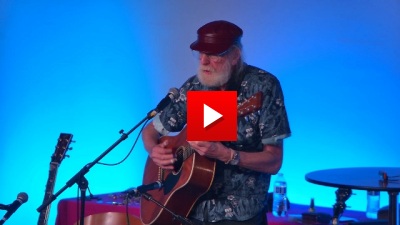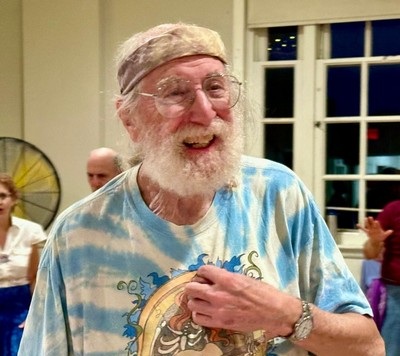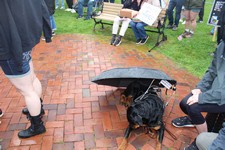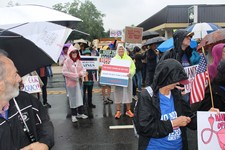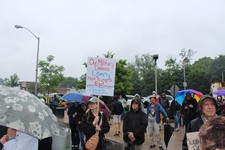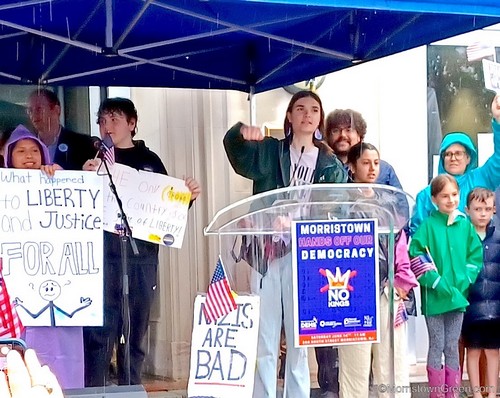A BIG Birthday
Eighty freakin' years old!! How the hell did that happen?
I never made a big deal about birthdays. I let 'em slide by with a minimum of fuss. But I can't ignore this one. Mortality keeps peeking its ugly eye out from behind dark corners with a knowing stare. I look at many of my contemporaries, and even those 10 years younger than me, and see unpleasant omens. General lethargy, canes and walkers, beer-bellies, tendencies to go to bed at 9:00, reluctance to go anywhere at night, reluctance to go anywhere at all, regimens of multi-colored pills, deaths, and other evidence of geezerdom. And now there's no getting away from it. I, too, am a registered card-carrying geezer. As John Gorka put it, "People My Age are Looking Gross."
So far, I have little to complain about. I'm still waiting for the first shoe to drop. All my parts are still working pretty well except my ears. (I do wear hearing aids. They help, but it ain't like having good ears.) My blood pressure and cholesterol are low. All my joints are working fine. I'm still running a mile every other morning. (I hate every minute of it. And as time goes by, there are more and more minutes of it to hate. My times generally run around 12 minutes plus or minus half a minute or so, whereas my best time ever was 8 minutes and 26 seconds around 20 years ago.) I'm still doing calisthenics every evening. I'm still hand-splitting all my firewood for heat in the winter. I still go out contra-dancing on a regular basis. (Although I now need to sit out every 3rd or 4th dance to catch my breath.) And I'm still gigging out whenever I can. (And surprisingly, my voice is better now than any time in my life!)
To what do I owe all this relatively good health. Certainly not my diet. I've lived my entire adult life on frozen dinners. My exercise regimen has probably helped. I'm no health freak; I derive no pleasure from it. It's an unwelcome chore. But 25 years ago when I first started, I realized that my life was too sedentary, and I needed to do something to remind my heart and lungs what they are supposed to do for a living. But more than anything I've done deliberately, I guess I attribute my general state of health to good luck and good genes. My parents both died of non-genetic diseases, and my uncle Albie ran his last New York City Marathon sometime in his late 70s, and almost made it to 99. See Blog entry of January 12, 2018.
And it's a big birthday, not only for me, but as well for the Folk Project's Troubadour Acoustic Concert Series, which as been an enormous part of my adult life. On my 30th birthday, July 25, 1975, I attended the very first concert of what was to become the Troubadour. I paid my $1.00 admission, and sat and watched a bunch of my friends perform at our brand new coffeehouse called "Good, Though". (The punch line of a story told by Utah Phillips, a popular folk performer of the time.) It took place in a basement room of what was then a French restaurant called L'Auberge Provinçal. Two years later I was booking the concerts. 50 years, 8 venue changes , and 5 name changes later, the Troubadour would be celebrating its 50th year of presenting a concert a week, year 'round, with only a few interruptions due to COVID, and a number of temporary building closures. I stopped booking it at the end of 2023, but the Folk Project and I had a number of celebrations between us to mark that milestone.
Celebration #1: Friday, July 18,
Folk Project Special Concert, featuring The Kingston Trio, with Mike Agranoff opening
One week prior to the actual 50th anniversary, the Folk Project scheduled a Special Concert to mark that milestone, featuring The Kingston Trio, and I was to open the show. Of course it was not the original cast of the Kingston Trio. But it was sort of like the old adage, "I replaced the handle, and my brother replaced the head, but it's still our father's ax." It was a good move for the 50th to present some of the music that was played around 1975, although the group's popularity had peaked several years earlier.
It was a pretty big deal for the Folk Project. Their name recognition, and probably the band's fee was an order of magnitude higher than what we usually present. We used the larger of the two halls in our facility which has a capacity of 300, and it was sold out. I had a 30 minute set, and I selected my repertoire appropriate to blend with that of the headline act. A little too appropriate, as it turned out. I had planned on doing "City of New Orleans" as my closing number. It's a good strong closer, and generally has the audience singing along by the end. Five minutes before I was to go on, I was alerted that the song was Also on the Kingston's setlist as well. I had to come up with another closer fast. I finally decided on Stan Rogers' "Mary Ellen Carter". Not of the era, but a strong closer nonetheless. Trouble was that it includes a pretty tricky guitar lick. I hadn't practiced the song in many months, and I didn't even have time to run through it once before I went on. I got through it OK, not technically perfect, but sufficient.
It was a very good night for me. I won't say I hit it out of the park, but I'd call it a good solid triple with a couple of RBIs tacked on. For that 30 minutes I owned that stage. I got a lot of positive feedback, both in the enthusiasm and length of the applause, and in fans old and new coming up to me in person during the intermission and after the show. There were even a few that told me they enjoyed my set better than that of the Kingstons. I sold a lot of CDs, and got about 35 new signees onto my mailing list.
Happy birthday to me indeed.
Celebration #2: Saturday, July 18
Sponsored Swingin' Tern Dance
|
|
|
The following day, Saturday the 19th, I gave my birthday present to the Folk Project by sponsoring our bi-monthly "Swingin'; Tern" contra dance. By "sponsoring", I mean paying for the rent of the hall and for the band and caller, and covering the ticket price for all the attendees. In turn, I was permitted to pick the band and the caller, and called one dance, and sat in with the band on concertina for another dance. The caller I picked was Bob Isaacs, who started his calling career at Swingin' Tern more than 10 years ago, and has come to be recognized as one of the country's premier contra dance callers and choreographers. And Brooklyn Swing is one of the favorite bands in the greater New York City region.
It was a really good dance, drawing more than 90 dancers (best by far in several years), drawn by the quality of the band and caller, and the free admission. There was birthday cake for all at the break. I received lots of congratulations, and compliments from attendees who had also seen my performance at the Troubadour the previous evening.
Contra Dancing,
For those of you unfamiliar with contra dancing, here's a little overview. Contra dancing and square dancing both spring from the same roots of European court dancing of the 17th and 18th Century, often depicted in Jane Austin movies and the like. The primary difference between the two is that contra dancing is done in a long line of couples facing couples, while square dancing is done in the more familiar formation of couples on the four sides of a square. There are other differences as well involving the music and the "feel" of the dance, better understood by actually doing it, rather than describing it.
The dance itself is a series of "figures', or patterns performed in time with the music by a couple of dancers, or by a pair of couples. (Do-si-do, Ladies' Chain*, Swing your Partner, etc.) Back in the time of those old court dances, one would go to a dancing master to learn the sequence of figures for many different dances. The American inovation was to have a "caller", who would call out the name of the figure shortly before it was to be performed, thereby eliminating the need for the dancers to memorize the sequence of every dance. The music is a simple melody of 64 measures, repeated over and over. The dance is choreographed such that the sequence of figures is completed within those 64 measures, but at the end of the melody, the couples who had been facing each other at the beginning find themselves back to back. That means each couple is now facing a new couple in the line, and this new foursome repeats the same sequence of figures. Each couple works their way down the line until they pop out at the end, having no one to dance with. They then get a minute to catch their breath, turn around and face in the other direction, and wait out the current repeat of the tune. . When that repeat of the tune is done, they are presented with yet another couple to do the dance with, and progress the other way down the line.
While there's a lot of structure involved in contra dancing, there's not a lot of terpsichorial (Look it up.) skill involved. There's no fancy footwork. It doesn't take a lot of physical dexterity. For the most part, the dance is simply walking in time to the music. The one exception is the swing. That can be done at a walk, but the more experienced dancers prefer the "buzz step". That's where the right foot is always forward of the left, and the left foot propels the dancer forward, as if on a skateboard. Take a look at the video above, and you'll see what I mean.
That video was made at the birthday dance, and gives you a good feel of what it's like. You can see some experienced dancers who add extra spins and variations, and other ornamentation. That is just fine so long as they end the figure on time, and where they're supposed to be for the following figure. And you see some beginners who may look a little unsure, but still are smiling broadly. The video encompasses the whole dance, except it doesn't catch the very beginning. You'll note that after a few times through the dance, Bob has stopped calling, because by that time the dancers have learned the sequence of figures. Around the 5-minute mark you can catch a glimpse of me in that tie-dye tee shirt at the far end of the line on the right.
Contra dancing is fun, social, and aerobic. It transformed me from a total dance klutz into a good dancer. As a kid, I was never good at any free-form dancing like rock and roll or swing, and I'm still not good at that. I think too much. And thinking is not good for any free-form activity. One needs to be able to just let go, and let the music dictate one's movement. I was never any good a letting go. But contra dancing gave me a structure. I knew I needed to be just here at just this moment, which gave my forebrain something to occupy itself with. That left my hindbrain free to take care of my body. And to my great surprise and unending delight, it seems to do a really good job of that. Look Ma, I'm dancing!
*"Ladies' Chain": To all you experienced contra dancers who may take umbrage at this obsolete term, yes, I know it's now called a Robins' Chain. I deliberately decided to use the older term because a lot of non-dancers may still be familiar with it from their high school days.
Celebration #3: Friday, July 25,
Troubadour Birthday Show
The Troubadour regularly presents its Birthday Show on the last Friday in July, as being closest Friday to the actual date of the first show we ever held in the basement of that French restaurant. And coincidentally, this year the last Friday fell on the 25th, 50 years to the day, and almost to the hour of that first show. (I say "almost", because we used to start our shows at 8:00 instead of our current 7:30 start time. That's because these days, some of us can't stay awake past 10:30 when the show used to close.)
The Birthday Show format is, as far as I know, unique in the music world. 3 weeks before the show on July 4th, the Folk Project holds a picnic. Any FP member who wants to be in the show, puts their name on an index card. (Remember index cards?) We shuffle up the cards, and deal out random duos and trios, and then each group has the intervening time to come up with one or two songs per group. And that's the show. We allow groups to add more musicians of their choice to the group, provided they are also Folk Project members, and the originally randomly chosen musicians are prominent in the ensemble.
The format can have difficulties from time to time. Musicians whose skills (or personalities) are not always compatible, or who live many miles from each other can be thrown together. But for the most part, it can be fun to see what they can come up with. And from time to time, the results can be memorable. I was paired up with a newcomer to the Folk Project named Dale Carpenter, originally from Arkansas. We came up with a nice program. We did one of his original songs, to which I added a concertina accompaniment. And then we did a medley that I had put together of "Mr. Bo-Jangles" and Paul Simon's "America", which slide nicely into each other. I would have included a video of that performance, except that I forgot some of the lyrics to "America" and would rather not share that with everybody.
I will share you the finale we did where all the musicians sang "Happy Birthday to Us".
Yup. It was a memorable 50th and a memorable 80th.
No Kings Day
So here I am. A stereotypical leftist, liberal (Dare I say woke?) Democrat, pushing 80 years old. And I've just came home from my first ever political rally. Where the hell was I during the 60s, when that was cool? I was complacent then. I had ultimate faith in the structure of our government and laws, and that the system would eventually prevail, and throw the bastards out. Also, if truth be known, I am more than a little bit of a coward. I was not comfortable presenting myself as a potential target for retaliation, either official, or otherwise.
But these are different times. Never before in my entire life have I actually feared that the United States was in real danger of losing its status as a democracy, and slipping into dictatorship. The very foundation of my existence is being pulled out from beneath my feet. I imagine that's how Americans, both Northern and Southern, must have felt when the Southern States seceded in 1860, or how Germans felt when Hitler seized control of their government in 1934. I have been supporting Democratic candidates for office monetarily for several years now, figuring I was doing my part. But coward or no, I reluctantly decided it was time to put boots on the ground.
Saturday, June 14 was National Flag Day. It was also Donald Trump's birthday, and he had decreed a military parade to take place in Washington on that day, conjuring images of similar demonstrations of power in Moscow, Beijing, and 1930's Berlin. To counter this, Act Blue and several other liberal organizations got together and proposed staging "No Kings Day" rallies on that day all over the country. In almost no time, almost 2,000 such demonstrations had been conceived and organized all around the country, in which over 5 million people participated. With more than a little trepidation, I decided to attend one of these events to be held in Morristown, my county seat. I called up old friends Ken and Pat Rolston, who live only a few miles from me, and asked if they wanted to join me. They said they had planned on taking part on their own, so at least I had some backup, and wouldn't be alone.
That was one factor that helped persuade me to take part. Another was that I knew I had the perfect design for a sign to carry. Back in 2016, when Trump was campaigning for his first term, and I was still on Facebook, (Haven't been for years, now.) I came up an idea for a meme to post. I knew it would take more graphic skills than I could muster, so I asked my friend Liz Pagan, a freelance graphic artist, to take my concept, and render it for me. The result was the image on the sign in the photo above, but without the red international "No" glyph. I still had the image file, and I did have sufficient graphic skills to superimpose that glyph. (I later realized that I had put the diagonal slash in the wrong direction, but it would have to suffice.) Fortunately, the image was of resolution high enough to blow up to poster size. I went down to Staples, and had them print it on foam-board. It was pretty pricey, but I figured, what the hell. In for a penny, in for 60 bucks. As it turned out, it was among the best and most professional looking signs I saw.
During the week before the rally, I was having second thoughts. Rain was predicted. Nearby parking would be nigh impossible. I was experiencing some odd pain in my right leg that would make walking difficult. Would I be allowed to wear a backpack where I could keep water and a rain poncho? Did I want images of myself carrying that sign posted on social media available for Trump's Gestapo to identify me via facial recognition software? Would there be violent counter-protesters to escalate the situation?
It was only late Friday afternoon when I made the decision to go. I would meet the Rolstons at their house, and we'd take the train together to Morristown, solving the parking issue. (It later turned out that there were numerous on-street parking spots we could have used on the walk from the station to the demonstration location at Morristown Town Hall.) As the morning wore on, I was feeling more and more comfortable. There were other demonstrators on the train with us. More joined us on the walk to Town Hall. (Only about half a mile, and the pain in my leg had faded.) Everything was non-violent, with no sign of counter-demonstrators. Even the rain turned out not to be an issue. It was a constant drizzle, which left my hat and flannel shirt damp, but did not soak me, and allowed the dampness to warm to body temperature, and cause me no discomfort.
The rally was well-planned. The whole event was not overlong; only 90 minutes, which was not tiring. Speeches were short, effective, and to the point. I didn't learn from them anything I did not know, but they were well-expressed, and uplifting. Although I couldn't see the podium from where I was standing, the sound system was good, and I could hear well, even with my diminished hearing. Any chants elicited from the speakers to the crowd were mercifully short. (Chanting the same three words over and over again bores me to tears.) According to an announcement from the podium, there were about 4,500 people in attendance. That seemed to me a touch over-optimistic, but not excessively so. In any event, it was not so crowded that one couldn't walk anywhere in the crowd without too much difficulty, or discommoding of others. There were about a dozen uniformed police on site, who, other than directing traffic around the closed-off street, just observed the event, which was enthusiastic, and completely non-violent.
During the rally, I left Ken and Pat a number of times to wander the crowd, both to see, and be seen. A lot of people asked me to stop so they could take a picture of me and my sign. (Facial recognition software be damned!) I took a lot of photos of signs I thought were well-conceived. I encountered a number of people I knew. I stopped by a number of policemen and thanked them for doing their job the way they were supposed to. Those remarks were greeted with smiles and thanks in return.
Among the speakers was Mikie Sherrill, my Congresswoman, whom I like very much, and who just this week won the primary election for Democratic candidate for Governor. A surprise speaker was Christie Todd Whitman, a Republican ex-governor of New Jersey. Another was Tom Malinowski, a Polish-born naturalized citizen, who later became a holder of several positions in the Obama administration, and a congressman from New Jersey. He led the crowd in the Oath of Citizenship that he took when he became a citizen, which he said was very similar to the Oath of Office he took as Congressman. (An obvious dig at the current President who has repeatedly and flagrantly violated his own Oath of Office.) The last speaker was a big, and very pleasant surprise. Miles Gorman, a senior in Morristown High School, deilvered a speech that was intelligent, literate, extremely moving, and well beyond his years, both in its text and delivery. He ended by asking any young people in the crowd to come up to the podium, and be recognized as model citizens. If that kid ever goes into politics, he will go far.
All in all, it was a very positive experience for me. I'm glad I did it, and may do so again. If you've been hanging out on the sidelines, watching these events on the news, I would recommend you get off your duff and do it yourselves if the opportunity presents itself. It may seem only a drop in the bucket, but many drops will fill the bucket.
Below, in no particular order, are some photos I took at the rally. Click on any photo for a full-screen blow-up to read the signs. (More effective on a computer monitor than on a phone.) Some of those signs are clever. Some are powerful. Some are both.
Postscript: Monday, June 14, 2025
This morning, I got an email from a friend, saying, "Hey Mike, you made the big time!" and pointed me to an article about Saturday's rally in Morristown Green, a local online news blog for the Morris County area. Sure enough, there was a photo of me with my sign. I asked the publisher, Kevin Coughlin if he would give me permission to use that photo in my Blog, as well as a photo of Miles Gorman, the closing speaker of the event. (I wasn't close enough to the podium to take a photo of Mr. Gorman during his speech). He graciously agreed. Many thanks to Morristown Green.
I went to visit my sweetie, Jenny in Vermont over the Memorial Day holiday. It was a lovely long weekend. On Saturday we went to see a performance by the New England College of Circus Arts. (Trapeze, ropes, tumbling, clowning, etc.) Sunday, we saw a series of six original 1-act plays by a local theater group, three of which were surprisingly good. (And three others, not so good.) And Monday we went to a pub sing in New Hampshire, where I gave a performance set preceding the group singing that followed. And then we capped off the evening at a contra dance.
Sunday evening, Jenny made dinner for the two of us and we had an uninvited guest at the table. See photo above.
An Open Letter to Republican Lawmakers
Dear Senator / Congressman / Congresswoman XXXX
You and I are witnessing the end of 250 years of American democracy and rule of law. And you, in your support of Donald Trump, are complicit in this disgrace. The world saw it in Germany in 1933. And we all know how it turned out for Germany, and for the rest of the world from 1941 to 1945. Do you want your name to be recorded in the history books as one of the perpetrators of this catastrophe? You, as a Republican Senator / Congressperson of the United States, have it within your power to put a stop to this. In your heart, you know it.
You are concerned that Trump will raise a primary against you in your next election. You have more to worry about than a primary. You will have the election itself to worry about when your constituents reject what the Republican party has become. Do you have the courage to put our country ahead of your own political gain (ephemeral though that may be) and stand up to this would-be despot? Life is short. Infamy is long. Which side are you on?
.
Antisemitism
I'm hearing a lot in the news these days about the rise of Antisemitism in the United States, as well as in the rest of the Western world. Of course, the very concept of Antisemitism is abhorrent to me, as are all other forms of racial or ethnic hate. Including Islamophobia. We must be very careful to differentiate between speech, thoughts, and actions directed against Judaism, and those in opposition to the State of Israel. What the State of Israel in general, and Prime Minister Netanyahu in particular has been doing in Gaza and the Palestinian territories over the past several years has nothing whatsoever to do with Judaism, and is enough to make me ashamed of my own Jewish heritage.
I was born to non-practicing Jewish parents, and grew up in Inwood, an upper Manhattan neighborhood that was at the time equally inhabited by Jews and Catholics. (I must have been well into my early teens before I realized that “Catholic” was not synonymous with “Christian”.) My father was an immigrant from the Ural Mountain region of Russia, who got out in his late teens along with his family. to avoid antisemitic persecution by the Soviets. And my mother was in a long line of several generations of Brooklyn Jews. I, myself, am a devout atheist, and have been as long as I can remember. I remember even as early as elementary school, declining to stay home on the Jewish holidays, reasoning that we were excused from school (NYC Public School system) in order that we might attend services, so that didn't apply to me. I remember having a wonderful time playing games, and socializing with all my Catholic friends in half-empty classrooms, where no real teaching was done, the teachers knowing that they’d have to make it all up anyway the next day when the Jewish kids came back.
But what is being done by Israel to the Palestinian people is appalling. Have we lost our memory? Have we forgotten Hitler’s "Final Solution" to the "Jewish Problem"? Israel is perpetrating its very own Holocaust in Gaza. The refugee camps there are its very own versions of Auschwitz and Dachau. Tthe Jewish “Settlements” are Israel’s very own Lebensraum. None of this has anything to do with Judaism, and everything to do with colonialism, ethnic cleansing and genocide. Where in the Scriptures does it say we should deny food, water, and medicine to a starving, thirsty, and injured people? What verse of the Torah might suggest it’s OK to rain artillery shells upon 100 innocent people in order to kill the half dozen terrorists hiding amongst them?
And what appalls me even more is that my own country is complicit in this shame. It is our artillery shells and our rockets, and bombs and drones that Israel is inflicting on these poor people. If we want to give Israel any weapons, I’m fine with Patriot anti-missile systems or other defensive weaponry. But not a single bomb or airplane or tank or bullet for offensive action. Don't get me wrong, Hamas is indeed a terrorist organization, and Israel has every right to defend itself. But as things stand now, Israel's terrorism is ten times that of
Winter Vacation in Virgin Gorda
Back in the '90s, Jenny had introduced me to Virgin Gorda, a tiny island in the British Virgin Islands I have very fond memories of it. We had stayed in a resort called Guavaberry Spring Bay, where we had a one-room bungalow of our own, a 5-minute walk from the resort's private beach. It was also a 15-minute walk from town where we would do our food shopping and occasional restaurant meal. If we wanted to explore the island, there was a rental car outfit called Mahogany Car Rentals that would either serve as a taxi or drop a car off at our door for a daily rental.
I loved the place. We paid it another visit in 2006, and I thought it was time we went back. Jenny agreed, and so we made our plans. The resultant trip was just as lovely, but with a couple of disasters thrown in at the very beginning and the very end of the trip just to keep things from being too perfect. Click the photo above for the story, the photos, and the videos.



